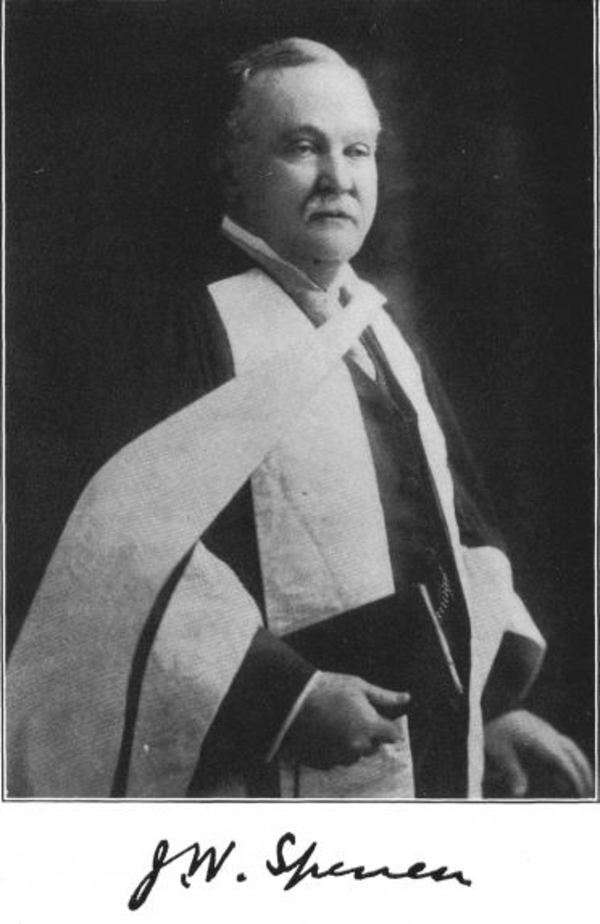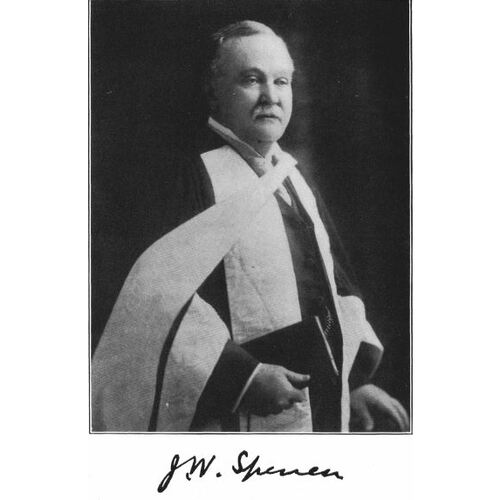
Source: Link
SPENCER, JOSEPH WILLIAM WINTHROP, geologist, teacher, geomorphologist, and author; b. 26 March 1851 in Dundas, Upper Canada, son of Joseph Spencer and Eliza Elenora Coe; nephew of James Spencer*; m. 15 April 1896 Katharine (Kate) Sinclair Thomson in Toronto; they had no children; d. there 9 Oct. 1921.
Joseph William Spencer’s great-grandfather Robert Spencer was a loyalist from New Jersey and New York who had served with Butler’s Rangers during the American Revolutionary War. Spencer believed that he was related to the Winthrops of Massachusetts and Connecticut, and after he moved to the United States, he added Winthrop to his name, though he generally signed J. W. Spencer. His father, who had founded the Gore grist and paper mills in Dundas, died when he fell from the roof of one of the mill buildings shortly after his son’s birth. Young Joseph was educated in Dundas, but in 1867 he and his mother moved to Hamilton, where he worked for two years for druggists T. Bickle and Son. By this time he was already interested in geology and chemistry, in part stimulated by his contact with amateur geologists active in the Hamilton Association, which sought to promote literature, science, and art.
In 1871 Spencer left to study geology at McGill College in Montreal, where he was a student of John William Dawson*. He graduated three years later with first-class honours in the new program of applied science. He then worked for a summer with the Geological Survey of Canada, as assistant to Robert Bell* in Manitoba. Both Dawson and Bell would remain close friends. Unable to find work in Canada, Spencer was briefly employed by Luther G. Emerson, a consultant for the upper Michigan copper mines, in 1875. After returning to Hamilton, he took up a position as science teacher at the Hamilton Collegiate Institute. In the summer of 1877 he travelled to Germany, where he obtained his doctorate at the University of Göttingen with a thesis on the Michigan copper deposits. He was only the second Canadian, after Bernard James Harrington*, to earn a doctorate in geology.
Spencer became professor of geology and chemistry at King’s College, in Windsor, N.S., in 1880. Two years later he was appointed to the chair in geology and mineralogy and curator of a new natural history museum at the University of Missouri. He helped to design, build, and equip the museum, but university president Samuel Spahr Laws’s plans ran into political and financial troubles, and Spencer lost his position. He joined the University of Georgia in 1888 and became state geologist two years later. He began a geological survey of the northwest part of the state, but soon faced political problems once again since he was more interested in stratigraphy than in gold mining. In 1894 he moved to Washington, D.C., where he worked as a consultant geologist until his return to Canada in 1920. He died in the following year and is buried in the family grave in Dundas.
Spencer’s first publication in 1875 dealt with the geology of the Hamilton region. Among other early work to appear in print was a paper on the Michigan copper mines read before the Natural History Society of Montreal in 1876 and published that year in the Canadian Naturalist (Montreal) and several on the Palaeozoic geology and fossils of the head of Lake Ontario. His significant research began with his study of preglacial valleys, including the buried Dundas valley, which he originally interpreted as part of an early river system (he called it the Erigan River) draining west through the Lake Erie basin. The work was encouraged by J. Peter Lesley, state geologist of Pennsylvania, whom he had met at a meeting of the American Association for the Advancement of Science, and was published in the Proceedings (Philadelphia) of the American Philosophical Society in 1882. Spencer later discovered evidence that the Erigan River had flowed, not up the Grand River and through the Dundas valley, but across the Niagara peninsula west of St Catharines. Further studies convinced him that all the Great Lake basins were originally eroded by a major river system draining east into the St Lawrence valley. He believed the original topography was preglacial and only slightly modified during the ice age.
As far as his teaching duties would allow, Spencer spent the years between 1881 and 1889 working on raised beaches of lakes formed at the end of the ice age (“proglacial lakes”). Many of these beaches were first mapped and named by him. That of the Lake Ontario basin he called the Iroquois beach, described in a paper published in the transactions of the Royal Society of Canada in 1890. By accurate mapping and levelling, Spencer soon discovered that the beaches were no longer level but had been tilted upward towards the north; furthermore, the higher (and therefore older) the beaches, the more they were tilted, a discovery which showed that the tilting was already in operation when the beaches were being formed. Spencer followed Dawson’s views about the ice age: he did not believe in the existence of massive ice sheets and attributed phenomena such as boulder clay and striated rocks to the action of floating ice. He therefore did not recognize that tilting of the beaches had been produced by “glacial rebound” (resulting from removal of the load of ice on the crust), but thought it was a widespread, fundamental tectonic process that had affected the whole of eastern North America. He was convinced that the Great Lakes region had stood much higher before the ice age, had been flooded by the sea in more recent times, and had then begun to rise again. Thus he believed that the proglacial lakes were actually marine or brackish, with floating ice, not freshwater lakes dammed by ice sheets, as American contemporaries such as Grove Karl Gilbert and Thomas Chrowder Chamberlin thought. Only in 1910 did Spencer admit (privately) that proglacial lakes were formed by ice-sheet dams, as Gilbert had first proposed in 1871.
Spencer’s earliest paper on Niagara Falls was published in 1887. He returned to the area often, even after he moved to the United States, and in 1905 he persuaded Bell, who was acting director of the Geological Survey of Canada, to sponsor a new study of the falls. Published in 1907, it involved a detailed re-survey of the crest line to determine the rate of recession and the first accurate determination of the depth of the river at the whirlpool and just below the falls. His theoretical analysis of the relationship between the rate of erosion and river discharge was criticized by Gilbert in a review published the following year in the journal Science (New York). As a result of his incorrect mechanical investigation and flawed study of the drainage history, Spencer’s estimates of the age of the falls could not be taken very seriously, even before the era of carbon-14 dating. Nevertheless, the book was generally well received at the time, and the survey data are still valuable.
After Spencer moved to Washington in 1894, he carried out many field investigations in the Caribbean and Central America. His study of the Caribbean islands also revealed evidence of large changes in land elevation, and the discovery of submarine canyons on the western Atlantic continental slope seemed to him further evidence in favour of his theories. Later work has shown that all these phenomena can be explained by agencies unknown in his day, without invoking the immense changes in elevation he proposed.
Joseph William Winthrop Spencer was an original fellow of the Geological Society of America in 1889. Among other honours, in 1919 he received an lld from the University of Manitoba, which awards the Winthrop Spencer Gold Medal in his memory.
[J. W. W. Spencer is the author of more than 100 technical publications, but many were abstracts or republications of material that had appeared elsewhere (a common practice at the time). Two good bibliographical sources which list many of Spencer’s works are J. M. Nickles, Geologic literature on North America, 1785-1918 (2v., Washington, 1923-24), and E. W. Shaw, “Memorial of Joseph William Winthrop Spencer,” Geological Soc. of America, Bull. (New York), 35 (1924): 25-36. In 1919 Spencer donated his collections and papers to the Univ. of Manitoba Libraries, Dept. of Arch. and Special Coll. (Winnipeg), MSS 30 (Spencer, J. W.), but the papers include no letters. Letters to J. W. Dawson are in MUA, MG 1022; to Robert Bell in LAC, MG 29, B15; and to J. P. Lesley in American Philosophical Soc. Library (Philadelphia), B L56 (J. Peter Lesley papers).
Spencer’s best known publication, which summarizes his work not only on the Niagara region but also on the evolution of the Great Lakes basins is The falls of Niagara: their evolution and varying relations to the Great Lakes; characteristics of the power, and the effects of its diversion (Ottawa, 1907). For a modern perspective, K. J. Tinkler, “Déjà vu: the downfall of Niagara as a chronometer, 1845-1941,” in Niagara’s changing landscapes, ed. H. J. Gayler (Ottawa, 1994), 81-109, contains a short section on Spencer and discusses his work in relation to other research on Niagara Falls, and K. J. Tinkler et al., “Postglacial recession of Niagara Falls in relation to the Great Lakes,” Quaternary Research (Orlando, Fla), 42 (1994): 20-29 cites Spencer briefly. g.v.m.]
AO, RG 22-305, no.44167; RG 80-5-0-241, no.490. Univ. of Rochester Library, Dept. of Arch. and Special Coll. (Rochester, N.Y.), A.F16 (Herman LeRoy Fairchild papers, 1869-1943). G. V. Middleton, “J. W. Spencer (1851-1921): his life in Canada, and his work on preglacial river valleys,” Geoscience Canada (St John’s), 31 (2004): 49-56; “J. W. Spencer (1851-1921): his life in Missouri and Georgia, and work on proglacial lakes,” Geoscience Canada (forthcoming); “The Spencers of Dundas” (speech given to the Dundas Valley Hist. Soc. (Dundas, Ont.), 21 April 2004; a copy can be found at www.unityserve.org/dundashistory/articles/0008.shtml). Morris Zaslow, Reading the rocks: the story of the Geological Survey of Canada, 1842-1972 (Toronto and Ottawa, 1975).
Cite This Article
Gerard V. Middleton, “SPENCER, JOSEPH WILLIAM WINTHROP,” in Dictionary of Canadian Biography, vol. 15, University of Toronto/Université Laval, 2003–, accessed December 12, 2025, https://www.biographi.ca/en/bio/spencer_joseph_william_winthrop_15E.html.
The citation above shows the format for footnotes and endnotes according to the Chicago manual of style (16th edition). Information to be used in other citation formats:
| Permalink: | https://www.biographi.ca/en/bio/spencer_joseph_william_winthrop_15E.html |
| Author of Article: | Gerard V. Middleton |
| Title of Article: | SPENCER, JOSEPH WILLIAM WINTHROP |
| Publication Name: | Dictionary of Canadian Biography, vol. 15 |
| Publisher: | University of Toronto/Université Laval |
| Year of publication: | 2005 |
| Year of revision: | 2013 |
| Access Date: | December 12, 2025 |



